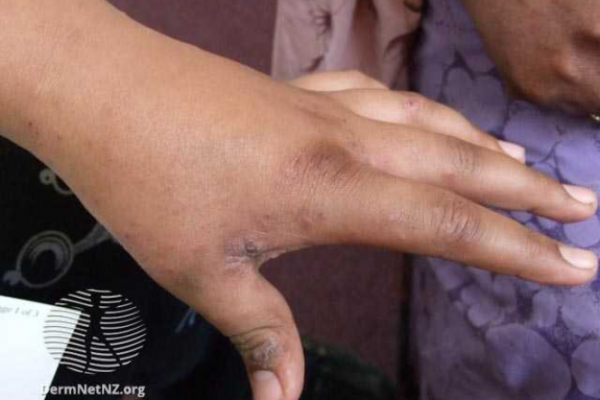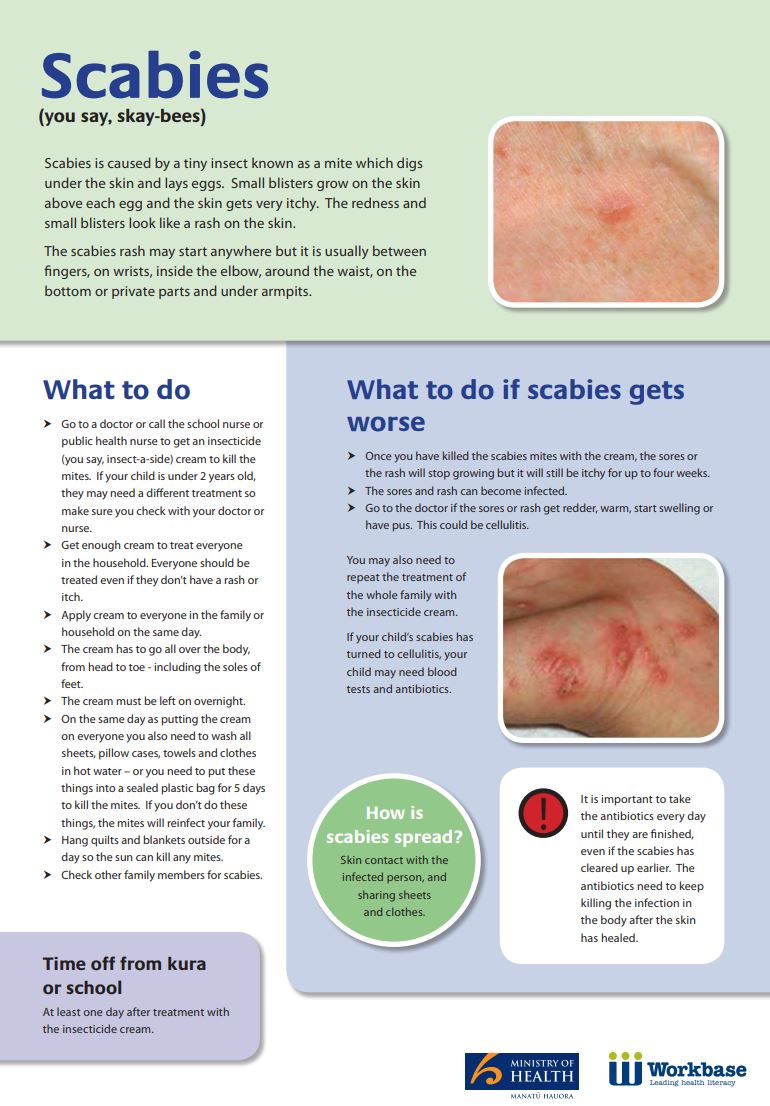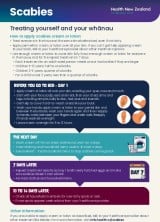Scabies | Mate māngeongeo riha
Key points about scabies (waihakihaki)
- Scabies (waihakihaki) is a contagious skin condition that causes a very itchy rash.
- The rash is caused by an allergic reaction to a tiny mite that burrows under your skin.
- It’s easily spread between people through close skin-to-skin contact or shared bedding or clothing, and won't go away without treatment.
- Everyone in your household should be treated at the same time, even if they don’t have symptoms.
- You’ll also need to wash all bedding and clothing in hot water at the same time.

Scabies is a very itchy skin rash that’s caused by a reaction to a tiny mite that gets under your skin.
- It’s easily spread through skin-to-skin contact with a person who has scabies, or through shared bedding or clothing.
- You need to treat scabies with a medication from your doctor or pharmacy. It won’t go away on its own.
- It can take time for the allergic reaction to develop, so people can be infected without symptoms. That is why everyone who lives in the same household as the person with scabies needs to be treated at the same time.
- You’ll also need to wash all clothing and bedding in hot water after treatment.
- The itch and rash may continue for a few weeks even though the mite is gone.
Scabies is caused by tiny mites that burrow along just under the surface of your skin, laying eggs as they go. Scabies mites are part of the arthropod family and are close cousins to spiders and ticks.
Scabies mites are so tiny you can't see them. Scabies is an allergic reaction to the eggs, poo (faeces) and saliva of the mite. Small lumps grow on your skin and your skin gets very itchy, especially at night or after a hot bath or shower. The redness and small lumps look like a rash on your skin.
The mite can survive on bedding and clothing for up to 4 days.
Scabies is usually spread by direct skin-to-skin contact with a person who has scabies. Contact generally needs to be prolonged so you’re unlikely to get scabies from a quick handshake or hug, but you could get it from holding hands or cuddling or sleeping with someone. It can also be spread by sharing clothing, towels, bedding or even furniture used by a person with scabies.
Anyone can get scabies. It has nothing to do with hygiene. It’s more common when you have lots of people in close contact. It’s easily spread to people you live with and to sexual partners.
Outbreaks can occur in houses with overcrowding or in rest homes. It isn't common for school children to pass scabies to each other.
It’s more common to get scabies in winter because the mite survives longer in the cold. Washing with soap won’t prevent or cure scabies.
Animals can also get scabies mites (it’s called mange in animals) but they’re a different kind that don’t survive or reproduce on humans. However, they can get under your skin and cause itching. If you think your pet might have mange then please take it to a vet.
One of the first symptoms of scabies is a very itchy rash. This is usually worse when you’re warm, such as when you’re in bed or after a shower.
Symptoms generally start 3 to 6 weeks after infestation with the scabies mite. However, if you’ve had scabies before, the rash can start after only 1 to 3 days.
- The scabies rash generally looks like lots of small red bumps. They're harder to see on dark skin, but you should be able to feel them.
- The rash can appear anywhere on your body.
- The most common places for the rash are:
- between your fingers
- on the underside of your wrists
- on the outer surface of your elbows and knees
- around your waist
- on your bottom or genitals (private parts)
- in your armpits.
- The rash doesn't usually appear on your head, although it may do so in very young children, older adults or people with a weakened immune system.
- You may have the scabies mite but no itching, but you can still spread scabies.
- Other conditions can cause a similar rash, so it can easily be confused with other skin conditions such as dermatitis or hives.

Image credit: DermNet NZ(external link)
See more images of scabies(external link) at DermNet NZ.
Talk to your healthcare provider or a pharmacist if you think you might have scabies.
Scabies is usually diagnosed based on your symptoms and examination of your skin. You’ll also be asked if you’ve had contact with any other itchy people.
It’s important to treat scabies as it won't go away by itself, and it’s easily spread to other people you have close contact with.
Also, scratching a lot can make skin conditions such as eczema or psoriasis worse. Scratching can also lead to skin infections such as impetigo or cellulitis.
See your healthcare provider again if the sores or rash get redder, warm, start swelling or have pus, or if you get a fever (high temperature). This could mean you have a skin infection that needs treating with an antibiotic or other medicine.
Scabies is usually treated with a lotion called permethrin which kills the scabies mite. You can buy this from your pharmacy or get it on prescription from your doctor or nurse prescriber. You need enough cream/lotion to treat everyone in your household, even if they don't have any symptoms. One 30 mL bottle is generally enough for an average sized adult, and children will need less.
It's important to follow the instructions for using permethrin carefully. The lotion or cream must stay on your body for at least 8 hours to kill the scabies mites.
You’ll need to apply the permethrin a second time 7 days later to treat any newly hatched larvae. You or your child can go back to work or school 24 hours after the first treatment.
Read more about permethrin and how to apply it.
Permethrin may not be suitable for everyone – you may need a different treatment
See your healthcare provider for advice before treatment if you:
- have open wounds or skin infections
- have crusted scabies (severe infestation)
- are bed-bound.
Although permethrin can be bought from a pharmacy without a prescription, it's important to talk to your healthcare provider if:
- you’re pregnant/hapu or breastfeeding
- you have children younger than 2 years of age.
Everyone in your household will need to be treated (see above). It's useful to make sure everyone has cut their nails and cleaned under them too.
Thoroughly clean personal items and living spaces
On the morning after everyone in your household has been treated, do the following.
- Use a hot wash cycle for all clothing, sheets, towels, pillowcases and stuffed toys used in the past 4 days (over 50o C for more than 10 minutes).
- If you have a tumble drier, put dry items on the hottest tumble dryer setting for at least 10 minutes.
- Any clothes, linen and soft toys that can't be washed can be placed in a sealed plastic bag for 4 days, including child car seats. Vacuum adult seats in cars.
- You don't need to wash mattresses or pillows if you have used sheets and pillowcases.
- Vacuum carpeted floors and upholstered furniture every day for 4 days.
If you don’t do these things, the mites can re-infest your whānau. If your household has had recurrent infections or treatment hasn't worked, it's important you do the things listed above.
Although the treatment kills the scabies mites quickly, the itching can carry on for a few weeks as it takes time for the allergic reaction to settle. The intense itch generally improves after 1 week of treatment. However, it can take 4 to 6 weeks for the itch and rash to clear completely, even though all mites have been killed. It’s important to follow all the treatment steps, including washing/cleaning household items (see above), to get rid of the scabies mites.
Treat itchy patches with antihistamines, moisturisers or mild steroid creams. Crotamiton cream (Eurax®, Itch-Soothe®) is used to reduce itch. Calamine lotion may also help relieve itching, but it won't kill the mites. Pinetarsol can be used in the shower to help relieve itch.
See your healthcare provider if the rash and itch haven’t improved 2 to 3 weeks after treating your household, or if your skin is still itchy 6 weeks after treatment
Other reasons you may still be itchy
- The diagnosis may be incorrect: Scabies can be confused with a number of other skin conditions, particularly dermatitis and hives. Coeliac disease is another cause of an ongoing itchy rash.
- You may need to repeat the scabies treatment: Ask your pharmacist or healthcare provider for advice. Don't repeat treatment more than twice without medical advice. Overuse of insecticides such as permethrin can irritate your skin.
- Not timing your treatment with that of close contacts: It's important that all close contacts are treated at the same time, otherwise you'll be re-infested and it won't work.
- Resistance to treatment. Scabies is sometimes resistant to the prescribed treatment. You may need to try a different treatment. If the itching continues, talk to your healthcare provider.
Scabies(external link) DermNet, NZ
Brochures
Scabies(external link) Workbase Education Trust and Ministry of Health, NZ, 2022
How to treat scabies [PDF, 115 KB] Northland DHB, NZ
Scabies(external link) HealthEd, NZ, 2025
References
- Scabies – diagnosis and management(external link) BPAC, NZ, 2022
- Scabies(external link) NHS, UK, 2023
- Te waihakihaki | Scabies(external link) Health New Zealand | Te Whatu Ora, NZ, 2024
- Scabies in adults(external link) Auckland Community HealthPathways, NZ, updated 2023
- About scabies(external link) CDC, US, 2024
Scabies(external link) DermNet NZ, 2022
Scabies | Mate māngeongeo riha (frailty care guides 2023)(external link) Te Tāhū Hauora | Health Quality and Safety Commission, NZ, 2023
Scabies – diagnosis and management(external link) BPAC, NZ, updated 2024
How do you get scabies?
Scabies is passed from person to person through skin contact. You can get it from cuddling or sharing a bed with somebody with scabies, or from sharing bedding, towels or clothing.
Will scabies go away on its own?
No, it won't go away on its own but needs to be treated twice (7 days apart) with permethrin lotion. If you don't treat it, you also risk spreading it to other people.
Can scabies kill you?
No scabies itself can't kill you but if it's not treated it can make existing skin conditions, such as eczema, worse. If you scratch your skin and it becomes infected, you could get impetigo or cellulitis. In the worst case, untreated cellulitis can lead to sepsis (blood poisoning) which can kill you.
Credits: Healthify editorial team. Healthify is brought to you by Health Navigator Charitable Trust.
Reviewed by: Dr Sara Jayne Pietersen, FRNZCGP, Auckland
Last reviewed:
Page last updated:







